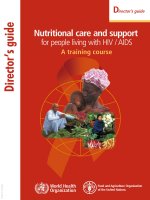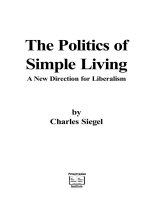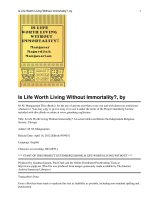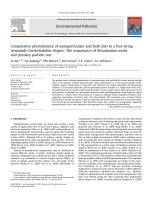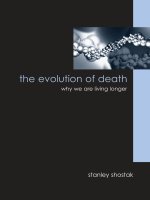- Trang chủ >>
- THPT Quốc Gia >>
- Hóa
Classifying living organisms
Bạn đang xem bản rút gọn của tài liệu. Xem và tải ngay bản đầy đủ của tài liệu tại đây (4.19 MB, 10 trang )
Genre
Nonfiction
Comprehension Skill
Compare and
Contrast
Text Features
• Captions
• Charts
• Glossary
Science Content
Classifying Living
Organisms
Scott Foresman Science 6.1
ISBN 0-328-13971-8
ì<(sk$m)=bdjhbc< +^-Ä-U-Ä-U
Vocabulary
adaptation
archaebacteria
bacteria
biosphere
classification
eubacteria
fungi
nonvascular plants
protists
species
vascular plants
Picture Credits
Every effort has been made to secure permission and provide appropriate credit for photographic material.
The publisher deeply regrets any omission and pledges to correct errors called to its attention in subsequent editions.
Photo locators denoted as follows: Top (T), Center (C), Bottom (B), Left (L), Right (R), Background (Bkgd).
3 Getty Images; 4 (R) Julie Mowbray/Alamy Images, (BL) ©Jerry Young/DK Images; 8 (BR) Getty Images;
9 (C) Nigel Cattlin/Alamy Images, (BR) Barry Runk/Stan/Grant Heilman Photography; 12 (CR) ©Jerry Young/DK Images;
13 (CLB, CBL, CBR, CRB) ©Jerry Young/DK Images.
Scott Foresman/Dorling Kindersley would also like to thank: 6 Linnean Society of London/DK Images;
8 (CL) Dr. Julian Thorpe/DK Images; 13 (TR) Natural History Museum, London/DK Images.
Unless otherwise acknowledged, all photographs are the copyright © of Dorling Kindersley, a division of Pearson.
ISBN: 0-328-13971-8
Copyright © Pearson Education, Inc. All Rights Reserved. Printed in the United States of America.
This publication is protected by Copyright, and permission should be obtained from the publisher prior to any
prohibited reproduction, storage in a retrieval system, or transmission in any form by any means, electronic,
mechanical, photocopying, recording, or likewise. For information regarding permission(s), write to
Permissions Department, Scott Foresman, 1900 East Lake Avenue, Glenview, Illinois 60025.
3 4 5 6 7 8 9 10 V010 13 12 11 10 09 08 07 06 05
What did you learn?
1. How do certain bacteria help people?
2. What are some ways fungi are harmful and some
ways they are helpful?
3. How have people adapted to living in a very
hot climate?
4.
There are millions of living
things on Earth. Write a short paragraph to
explain the value of having a classification system
by Mary Walsh
for living organisms. Include a description of the
system scientists invented and how it developed
over time.
5.
Compare and Contrast Species have to adapt
to their environment. How alike and how
different are birds and mammals? Support your
answer with examples.
Where do
organisms live?
The Biosphere
There are millions of living things on
Earth we already know about. Scientists believe
that there are still a large number that haven’t
been discovered yet. There are many living
things around us, such as plants and animals.
You know that there are also many living
You might find a piece
things in the ocean, in the desert, and even
of bread with mold on
in the air. But if you could shrink Earth to
it in a kitchen. The bread
the size of an apple, the area where you would
is part of the environment
for a living mold.
find living things would be equivalent to the
apple’s skin!
The part of Earth that can support living things is called
the biosphere. All living things and their environments together
make up the biosphere. There are many types of environments in
the biosphere: oceans, deserts, parks, yards, and even sidewalks
in the middle of cities.
Scientists have already found nearly two million organisms in
Earth’s biosphere. They name about ten thousand new ones each
year, and they think there are still millions more to be discovered.
Why are there still so many new types of organisms to be
discovered? One reason is the size of our planet. The oceans are
very deep and many areas of land have not been fully explored.
Also, some organisms are very tiny and hard to find.
Each organism in the biosphere interacts with other
organisms and their environment. Each one competes for
the resources available. We also play an important role in the
environment. Our actions affect the environment and the
organisms living within it.
2
Living Things Are Alike
and Different
You can usually recognize
a cat. Even if it’s a different
color or size or has a different
kind of fur than another cat,
you know a cat when you
see one.
This is an example of a
species. A species is a group
of individuals that are similar
and can reproduce to make
more of themselves.
In the chart below you see
an estimated number of known
species for different groups of
organisms. This chart shows
the species that are alive today.
Some scientists think that
99 percent of all species that
were ever alive no longer exist.
Group
Vertebrates
Mammals
Birds
Reptiles
Amphibians
Fish
Invertebrates
Plants
Even though these cats have different
fur and a different shape, they are still
members of the same species.
Number of
Living Species
42,000
4,000
9,000
6,000
4,000
19,000
980,000
248,000
3
Sometimes Living Things Change
An adaptation is a characteristic that helps an organism
survive or reproduce in its environment. Plants and animals
whose adaptations fit an environment are more likely to
survive than plants and animals whose adaptations do
not. For example, giraffes eat leaves. But so do many other
animals. The giraffe’s long neck is an adaptation that allows
it to reach leaves in the tops of trees that many other animals
could not reach.
Another example is the redwood tree, Sequoia
sempervirens. These trees are among the tallest and oldest
living things. Redwoods produce a substance called tannin
that repels insects, fungi, and many animals that would
otherwise eat the tree’s bark or leaves. They can also take in
more than 2,000 liters of water in a single day. These are just a
few of the adaptations that help the redwoods survive in their
environment. Many live more than fifteen hundred years.
Sometimes environments change. When they do, plants
and animals whose adaptations fit this change are likely to
survive. There was a moth in Europe that was a light color
until about the 1850s. That was when people started to
build factories that sent a lot of black smoke into the air.
The smoke would settle on the bark of trees and make them
black. The predator of the moths could see the moths easily
when they were a light color on black bark. Darker moths
were better suited to survive in their environment. Over
time, most surviving moths were darker in color.
Look at the organisms in these photos. Each one has an
adaptation that makes it able to survive in its environment.
The hummingbird has a
long beak so it can suck
up the nectar from inside
a flower.
The spines of the cactus
are actually leaves.
Their shape helps the
plant to conserve water.
The anteater’s snout is long so it
can slurp up ants on the ground.
The monkey’s long tail lets
it swing from tree to tree.
Redwood trees are
among the tallest and
oldest living things.
4
The hard shell of this turtle
protects its soft body.
5
Classifying Organisms
in Categories
Scientists need a way to talk
about the millions of organisms
that we know about on Earth,
so many years ago they invented
a system to organize them.
Imagine that you have just
completed washing and folding
your clothes. But you need to
put them in your dresser or your
closet. Right now socks are mixed
in with shirts, and jackets are mixed
Carolus Linnaeus classified
in with pants. So the first thing
organisms in two categories:
you do is group them. You put
plants and animals.
the things you wear when you go
outside in the closet, and things that you wear in the house in the
dresser. Things that you wear to bed go in one drawer, and things
that you wear during the day go into another. Grouping things
according to their similar characteristics is called classification.
Scientists also classify living things. Their system of
classification is based on the structure of an organism, how it
reproduces, and how it feeds.
Carolus Linnaeus was a doctor who worked with plants in
the 1700s. He divided living things into two groups, or kingdoms:
Animals and Plants. Animals are capable of moving themselves
(locomotion), while plants are not. When a plant moves in the
wind, the wind is moving it—it is not moving by itself.
The Six Kingdoms
Since Linnaeus, other scientists have added new groups to
classify living things. We now have six kingdoms altogether.
This has been possible because we now can see things that
are not visible to the naked eye. With microscopes we can see
organisms that Linnaeus did not know existed. For example,
we now know that bacteria exist: single-cell organisms that
were once the only form of life on Earth.
The six kingdoms of classification depend on how an
organism gets its food, how it reproduces, and the kind of
cell wall it has. Each kingdom is divided up into smaller and
smaller groups based on organisms’ specific characteristics.
The first kingdom, Archaebacteria,
is a group of bacteria made up of one
cell each, with unusual cell walls.
Archaebacteria can live where there is
no oxygen. Some live beneath the surface
of the Earth, where temperatures are very
high. Others make natural gas, which we
can use to heat our homes.
The kingdom Eubacteria includes
several different types of bacteria. One
Some Archaebacteria grow
type takes nitrogen from the air and fixes
on undersea steam vents.
it so plants can absorb it. Plants need
nitrogen to make their own food. Without
these nitrogen-fixing bacteria, many plants
and animals would die.
Other members of Eubacteria cause
diseases such as botulism and tuberculosis.
Botulism can occur when food has not
been canned properly; it can kill a person.
Many of us carry the tuberculosis
bacterium around with us, but we are
strong enough that it doesn’t make us sick.
Eubacteria
6
7
The Protists kingdom includes many one-celled organisms,
such as the amoeba and paramecium. There may be more than
two hundred thousand protists that have only one cell.
The Protists also include some algae, which can make their
own food, and some “slime molds.”
The Six Kingdoms
Archaebacteria
These are the
most ancient of
all living things
on Earth. They
can use chemicals,
such as hydrogen
sulfide, to create
energy. We can find them living in hot
springs.
Fungi
Fungi lack
chlorophyll,
so they cannot
make their
own food. They
resemble plants
because of their appearance and
because they have no locomotion.
Eubacteria
Some of these
bacteria cause
disease. For
example, the
Salmonella typhi
sometimes comes
from fruits and
vegetables that are not washed
properly; it causes typhoid fever.
Another called Streptococcus can
destroy the enamel on your teeth.
Plants
The Plant
kingdom is the
most abundant
of the six
kingdoms
on Earth.
Protists
This kingdom
includes red,
brown, and
green algae.
8
Animals
This kingdom
includes organisms
we normally
consider animals,
as well as some we
might not. Sponges,
which live in the
ocean, are in
this group.
Maybe you have been in the woods and seen
mushrooms growing. Mushrooms are Fungi,
the fourth kingdom. These organisms resemble
plants but have no roots, stems, or leaves. Fungi
(plural of fungus) have no chlorophyll, so they
cannot make their own food. Instead, they have to
live on other organisms that can provide food.
You have probably seen other types of fungi as well.
For example, if you have ever had a piece of bread go bad,
it got mold on it. That mold is a type of fungus.
Some fungi are very helpful to people. Penicillin, a medicine
that fights infection, comes from fungi. We use yeasts to make
bread rise and certain other fungi to make cheese.
Other fungi are not so helpful to people. For example,
one causes athlete’s foot. There is another called wheat rust,
which is a fungus that can destroy millions of crops.
wheat rust growing
on a wheat stalk
This fungus is sending
spores into the air, which
will create more fungi.
close-up of the
wheat rust
9
How are plants and
animals classified?
The larger the plant’s
leaves, the more
chlorophyll it has
and the more food
it can make.
You are already familiar with
many members of the Plant kingdom.
From the massive redwood trees of
California to the flowers you pass
on your way to school, there are
many types of plants. We find plants
everywhere—from sidewalks to parks
to bodies of water. They provide all
of what we eat in some way. If we eat
animals, they have eaten plants also.
Even if an animal eats other animals,
the other animals may have eaten
some plants. If we don’t eat animals
for our food, then we eat plants
directly.
Most plants take the energy from
the Sun and convert it into food. They
do this using chlorophyll, a substance
in their cells, through a process called
photosynthesis. Plants need sunlight,
nutrients, and water to make food.
Our Lady’s plant collects
water around its leaves
so it has water when it
needs it.
10
Classifying Plants
You know some characteristics that
almost all plants have, such as making
their own food. Some plants have other
characteristics that make them different.
One way they are different is how they
Here is a pinecone and
move water inside.
some of its seeds.
Plants need water to make food. When
the plant is very tall, as the redwood tree is,
the water and food must travel inside in tubes. These are
called vascular plants. There are more than 260,000 species
of vascular plants.
Some plants must pass water from one cell to the next.
These plants have no tubes, so they are called nonvascular plants.
You can tell that these plants must be very small, because the
plant has no easy way to move the water up or down. There are
about 18,000 species of nonvascular plants.
Scientists divide vascular plants into two groups—those that
make seeds and those that don’t. You know plants that make
seeds. For example, when you cut an apple or an orange, there are
seeds inside. These plants are called angiosperms.
Many plants that make seeds also
produce flowers. Some evergreens make
seeds but don’t make flowers. Pinecones
hold the seeds the tree produces. These
plants are called gymnosperms.
There are some plants without seeds,
such as ferns. Ferns reproduce through
spores and need a humid environment.
Plants that have seeds can adapt to drier
conditions than most seedless plants. That
is why there are few plants without seeds.
Ferns and horsetails belong to this group.
Dandelions during and after flowering—
the seeds are left after the plant has flowered.
11
Classifying Animals
Classes Are Not Just for School
The Animal kingdom includes many different kinds of
organisms. They all have some things in common. They all ingest
food. But they get it from somewhere else instead of making it
like plants do. All animals have specialized tissues, except for
the sponges. For example, most animals have a mouth to chew
food and a stomach to digest it. Every living thing in the Animal
kingdom can also move on its own at some point in its life and
can reproduce, usually by mixing cells with another parent.
Before we look at subgroups in the Animal kingdom, let’s see
how we might classify things in a “Vehicles” kingdom. We could
use a chart like the following:
Now let’s look more closely at how scientists
classify dogs, using a similar system. Look at the
photos below to see what each category stands for.
Kingdom:
Vehicles
Phylum:
All vehicles with wheels
Class:
Vehicles with wheels that
are used to transport people
Order:
Vehicles with two wheels that
transport people
Family:
Small vehicles with two wheels
that transport only one person
Genus and
Species:
Kingdom:
Animals
Phylum:
Chordata
Class:
Mammalian
Order:
Carnivore
Family:
Canidae
Genus and
Species:
Canis familiaris
Street bike
You see that the groups keep getting smaller and smaller.
Genus and species: Canis familiaris
The dog that lives in homes with
people is named with both its
genus and its species. This is
a convention that helps to
identify any organism.
12
Family: Canidae
This includes various
animals related
to dogs. A fox
belongs to the
family of dogs.
Order: Carnivore
Carnivores eat
animal flesh. They
have large, strong
teeth with sharp
cutting edges.
Class: Mammalian
Mammals are
warm-blooded
animals whose
babies drink milk
from the mother.
Phylum: Chordata
This phylum includes
birds, reptiles, fish, and
mammals. They have
a nerve cord that runs
below their back.
Kingdom: Animals
This kingdom is
made up of all
animals, including
insects and fish.
13
More on Animal Classification
You saw the word phylum when we were talking about
vehicles and dogs. In the Animal kingdom there are
about thirty-five phyla (the plural of phylum).
Here are pictures from some of the phyla. Both
the bird and the gorilla belong to the same phyla
and have backbones. They are called vertebrates.
The rest of the animals without a backbone
are called invertebrates. More than
90 percent of the animal species
on Earth are invertebrates.
Phylum Annelida
This peacock worm lives on
the ocean floor. The feathers
are tentacles that it uses
to catch food. This phylum
also includes earthworms.
Phylum Mollusca
Most mollusks have a soft body and
a foot that they use to get around.
The foot sticks out from the shell.
Phylum Arthropoda
Arthropoda is the largest animal phylum.
More than a million species have been named.
The tarantula has legs with joints, a complete
digestive tract, and a body with segments.
14
Phylum Chordata (Subphylum Vertebrata)
You can see that this gorilla is very different
from the bird. The gorilla is in the class
that feeds its young milk from the mother’s
mammary glands.
Phylum Chordata (Subphylum Vertebrata)
This bird is in the same category as the gorilla,
but in a different class. Birds lay eggs, have
lungs and feathers, and most have wings
that they use to fly.
Scientists often need to classify organisms into smaller
groups than the kingdom, phylum, or class. Phyla can be
divided into classes and classes can be divided into orders.
Orders can be divided into families, and families into genera
(the plural of genus) and species.
The number of organisms in a classification group
decreases as the groups become more specific. As we move
from broad groups like kingdom to more specific groups
like family and genus, members of the group become fewer
but more alike. Animals in the same genus share many
characteristics, but only members of the same species can
produce offspring.
This system of classification allows scientists to classify
new organisms as they are discovered, and there are many
species yet to be discovered. Perhaps one day you might be
lucky enough to find and classify a new species!
15
Vocabulary
Glossary
adaptation
archaebacteria
bacteria
adaptation
a characteristic that enables an organism to survive
biosphere
and reproduce in its environment
classification
eubacteria
archaebacteria group of bacteria made up of one-celled organisms
fungi
nonvascular plants
bacteria
single-cell organisms that were once the
protists
only form of life on Earth
species
vascular plants
biosphere
all living things and their environments
classification
the process of grouping things according to
common characteristics
eubacteria
organisms that can cause diseases and can also
be beneficial
fungi
organisms that have no roots, stems, or leaves
and cannot make their own food; so they have
to live on other plants that can
Picture Credits
Every effort has been made to secure permission and provide appropriate credit for photographic material.
The publisher deeply regrets any omission and pledges to correct errors called to its attention in subsequent editions.
nonvascular
plants whose water and food get passed from
plants
cell to Images,
cell (BL) ©Jerry Young/DK Images; 8 (BR) Getty Images;
3 Getty
Images; 4 (R) Julie Mowbray/Alamy
Photo locators denoted as follows: Top (T), Center (C), Bottom (B), Left (L), Right (R), Background (Bkgd).
9 (C) Nigel Cattlin/Alamy Images, (BR) Barry Runk/Stan/Grant Heilman Photography; 12 (CR) ©Jerry Young/DK Images;
13 (CLB, CBL, CBR, CRB) ©Jerry Young/DK Images.
protists
mostly one-celled organisms, including some algae
species
a group of individuals that are similar and can
produce offspring that are similar
vascular
plants
plants whose water and food travel inside in tubes
Scott Foresman/Dorling Kindersley would also like to thank: 6 Linnean Society of London/DK Images;
8 (CL) Dr. Julian Thorpe/DK Images; 13 (TR) Natural History Museum, London/DK Images.
Unless otherwise acknowledged, all photographs are the copyright © of Dorling Kindersley, a division of Pearson.
ISBN: 0-328-13971-8
Copyright © Pearson Education, Inc. All Rights Reserved. Printed in the United States of America.
This publication is protected by Copyright, and permission should be obtained from the publisher prior to any
prohibited reproduction, storage in a retrieval system, or transmission in any form by any means, electronic,
mechanical, photocopying, recording, or likewise. For information regarding permission(s), write to
Permissions Department, Scott Foresman, 1900 East Lake Avenue, Glenview, Illinois 60025.
3 4 5 6 7 8 9 10 V010 13 12 11 10 09 08 07 06 05
16
What did you learn?
1. How do certain bacteria help people?
2. What are some ways fungi are harmful and some
ways they are helpful?
3. How have people adapted to living in a very
hot climate?
4.
There are millions of living
things on Earth. Write a short paragraph to
explain the value of having a classification system
for living organisms. Include a description of the
system scientists invented and how it developed
over time.
5.
Compare and Contrast Species have to adapt
to their environment. How alike and how
different are birds and mammals? Support your
answer with examples.

